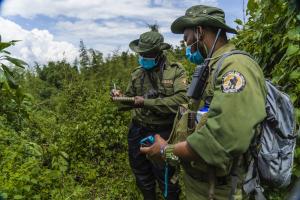5x more rangers needed to manage protected areas worldwide by 2030
University of Hawaiʻi at MānoaDirector, HIMB, School of Ocean and Earth Science and Technology
Marcie Grabowski, (808) 956-3151
Outreach specialist, School of Ocean and Earth Science and Technology
A first study of its kind outlines an urgent need for larger numbers and better-supported protected area staff to ensure the health of life on Earth. In a new scientific paper published in Nature Sustainability, an international team of scientists, including one from University of Hawai‘i at Mānoa, argue that there are not enough rangers and other staff to manage the current protected areas around the world. This is the first estimate of the global number of protected area personnel since 1999 and the first to specifically include rangers.
The study comes ahead of the global meeting of the Conference of the Parties in Montréal, Canada, December 7–15, which decides new targets for conservation. The authors urge governments, donors, private landowners and non-governmental organizations to increase the numbers of rangers and other staff five-fold in order to meet global biodiversity conservation goals that have economic, cultural and ecosystem benefits.
“Sufficient staffing is fundamental to the success of conservation initiatives” said Eleanor Sterling, study co-author and director of the Hawai‘i Institute of Marine Biology in the UH Mānoa School of Ocean and Earth Science and Technology (SOEST). “Protected area personnel have a critical role to play in ensuring implementation of this conservation strategy honors local and national values.”
Conservation requires international effort
Governments around the world will come together at the 15th meeting of the Conference of the Parties to the Convention on Biological Diversity with the intention to commit to protecting 30% of the planet's wild lands by 2030 (widely referred to as “30 by 30”).
"Our protected areas system is the life support of the planet, providing people with water and clean air, storing carbon and preventing biodiversity loss," said Mike Appleton, Re:wild's director of protected area management and lead author of the paper. "Yet there are more people employed at golf courses and country clubs in the United States than there are rangers in the world. The 30 by 30 target is an important goal. It becomes meaningless if we aren't also willing to invest in people to effectively and equitably manage these places."
Using data from 176 countries and territories, the study estimates that there are only 555,000 protected area personnel worldwide responsible for 17% of the world's land surface (more than 20 million square kilometers). Only 286,000 of them are rangers, who directly manage protected areas, uphold laws, work with visitors and local communities and monitor wildlife. Rangers also act as tour guides, firefighters, environmental defenders and play many other roles. Examples of protected areas include national parks, nature reserves, landscape reserves, conservation areas, natural monuments, state parks and certain areas under sustainable Indigenous and traditional management.
Indigenous, local communities vital to success
Co-author Alexandre Courtiol from the Leibniz Institute for Zoo and Wildlife Research (Leibniz-IZW) in Berlin led the team of scientists who calculated that the effective protection and management of 30% of the planet's land surface by 2030 will require a workforce of at least 2.9 million people, including 1.53 million more rangers. Alongside government protected areas, many new types of areas will need to be conserved by personnel in the private and non-profit sectors and, vitally, by Indigenous and local communities managing their own territories.
“Any strategy that encompasses 30% of the planet’s land surface will involve resources and spaces governed by Indigenous peoples and local communities, who may themselves have important considerations regarding who manages and how management responsibilities are transmitted between generations,” said Sterling.
"This critical work is timely as our continued existence on this planet is becoming increasingly fragile because of the human-induced crises, climate change and biodiversity loss," said Madhu Rao, chair of the IUCN World Commission on Protected Areas. "For any country or region to stand a chance of attaining the ambitious global targets that are being set to mitigate these detrimental effects, there needs to be a significant investment in the people tasked with securing wildlife, natural ecosystems, natural resources and the communities and cultures that have sustained them for millennia. For ambitious global targets to be meaningful and effective, we need more committed, competent and well-supported personnel on the ground."
The scientific investigation was led by a collaboration between Re:wild, the IUCN World Commission on Protected Areas, the Leibniz-IZW, WWF, Game Rangers Association of Africa, International Ranger Federation and the Ranger Federation of Asia.


